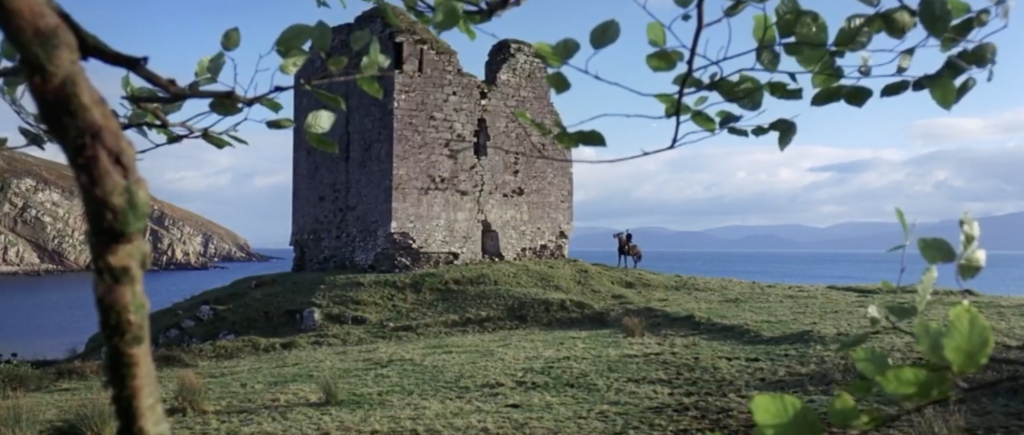Ryan's Daughter - Minard Castle
Caisleán na Mine Airde
|
Minard Castle
Address
Cill Mhuire, An Mhin Aird, Corca Dhuibhne
52.126377
, -10.110510

Although its appearance is brief in the film, Minard Castle makes for a striking location for the clandestine meeting of Rosy Ryan (Sarah Myles) and Major Randolph Doryan (Christopher Jones). This 16th century tower house was built by the Fitzgerald family, and was destroyed by cannon and gunpowder in 1650 by Cromwellian forces, under the command of Colonel Edmund Ludlow, who were pursuing Walter Hussey. They positioned their cannons in a nearby medieval fortified settlement, Cathair na nAcraí, at the other end of the bay, and blew the eastern end off the castle. Although only three storeys remain, it is likely to have had a fourth, attic storey. It is now in the private possession of the Johnson family, and any attempt at access will require permission from the landowners.
Without a doubt, Ryan’s Daughter put the Dingle Peninsula on the modern map – literally, figuratively, and in all-ways speaking. West Kerry’s history as a destination for early Christian ascetics, Spanish merchants, and even early sound era filmmakers (see: West of Kerry) notwithstanding, Dingle and its surrounds were an economic backwater (if not wasteland) in the middle of the twentieth century. Then came Ryan’s Daughter.
The best resource on Ryan’s Daughter (and some very fine storytelling) comes from local historian Micheál De Mordha in his Irish-language book An Rialtas Ab Fhearr! (The Best Government Ever!) In it, he tells the full story of how internationally acclaimed English director David Lean (Lawrence of Arabia and Doctor Zhivago) brought his epic vision (adapted from Madame Bovary) – along with stars Robert Mitchum, Vera Miles, Trevor Howard and John Mills (who won an Oscar for his portrayal of the intellectually impaired Michael) – along for its (over)shoot, ultimately jump-starting West Kerry economically and cementing its status as a tourist destination. Cinephile pilgrims still flock to the one still-standing structure of the set, the “Ryan’s Daughter schoolhouse”, which was specially built for the film and the only building allowed remain by the production company (following local squabbling over private ownership).
Today the schoolhouse’s roof has fallen in, and it is little more than a boxed shell. Yet it stands starkly against the Dunquin coastline, partially viewable from the Slea Head Drive and accessible on foot from the Ionad an Bhlascaoid. It is just a couple of yards from the ancient holy well, Tobar Ghobnait, which is dedicated to St Gobnait, the patron saint of Dunquin. This site, too, receives its own pilgrims and worshippers today. Like so many locations in West Kerry, the ancient abuts the modern here, religion mixing with secularism, commercialism with art.
This is some of what makes Ryan’s Daughter so rich: a film about ideological conflict (loyalism versus Republicanism; fidelity versus passion) is itself so complex and conflicted in terms of its production history, its juggling of geographical locations (West Kerry in one shot is represented by a strand in South Africa in the next), its propulsion of loosening censorship practices in Ireland and the MPAA system (thanks to its nude scenes), and the “value” ascribed to it by film critics versus business analysts.
Inarguably, Ryan’s Daughter is aesthetically beautiful to look at, with cinematogapher Freddie earning an Oscar for its 1970 release. It remains for the viewer to decide whether the narrative substance behind its aesthetic veneer is separable or not, factorable in, and/or discountable towards in any individual assessment of the film’s overall “quality”. Perhaps it may come down to whether the film affects the individual audio-viewer emotionally, and in what way, through narrative and/or purely aesthetic appreciation. Regardless, this film was and always will be fundamental to understanding West Kerry economics and culture today.

